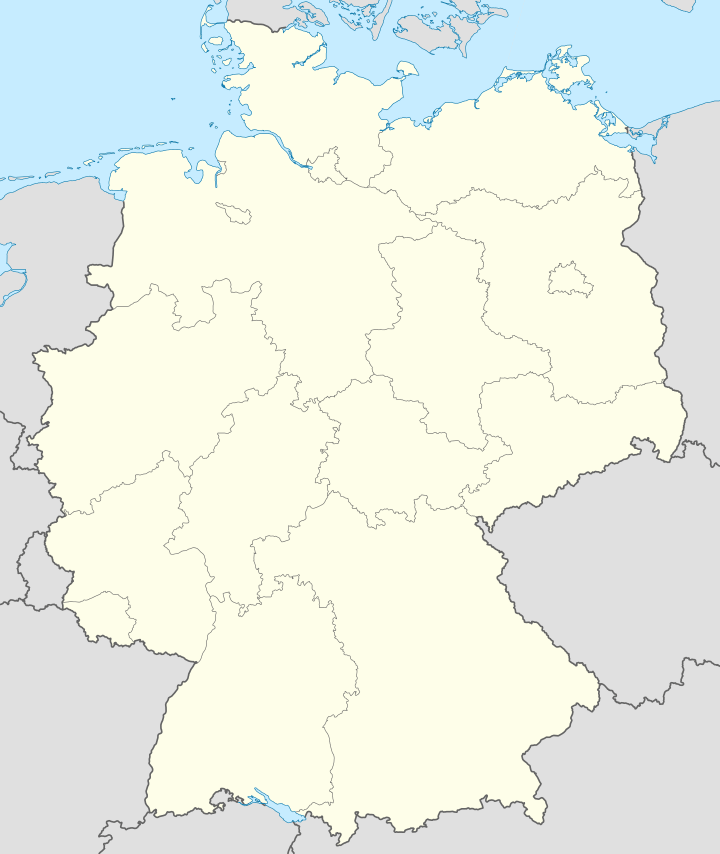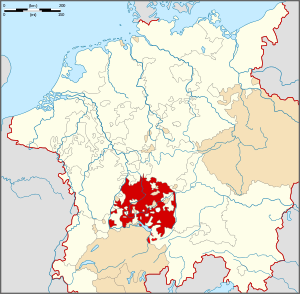Sigmaringen
| Sigmaringen | ||
|---|---|---|
 | ||
| ||
 Sigmaringen | ||
Location of Sigmaringen within Sigmaringen district  | ||
| Coordinates: 48°5′12″N 9°12′59″E / 48.08667°N 9.21639°ECoordinates: 48°5′12″N 9°12′59″E / 48.08667°N 9.21639°E | ||
| Country | Germany | |
| State | Baden-Württemberg | |
| Admin. region | Tübingen | |
| District | Sigmaringen | |
| Government | ||
| • Mayor | Thomas Schärer | |
| Area | ||
| • Total | 92.85 km2 (35.85 sq mi) | |
| Population (2012-12-31)[1] | ||
| • Total | 15,517 | |
| • Density | 170/km2 (430/sq mi) | |
| Time zone | CET/CEST (UTC+1/+2) | |
| Postal codes | 72481–72488 | |
| Dialling codes | 07571 | |
| Vehicle registration | SIG | |
| Website | www.sigmaringen.de | |
Sigmaringen is a town in southern Germany, in the state of Baden-Württemberg. Situated on the upper Danube, it is the capital of the Sigmaringen district.
Sigmaringen is renowned for its castle, Schloss Sigmaringen, which was the seat of the principality of Hohenzollern-Sigmaringen until 1850.
Geography
Sigmaringen lies in the Danube valley, surrounded by wooded hills in the south of the Swabian Alb around 40 km away from the Lake of Constance.
The surrounding towns are on the north, Winterlingen (in the district of Zollernalb) and Veringenstadt, on the east, Bingen, Sigmaringendorf, and Scheer, on the south, Mengen, Krauchenwies, Inzigkofen, and Meßkirch, and on the west, Leibertingen, Beuron, and Stetten am kalten Markt. The city is made up from the following districts: Sigmaringen (inner-city), Gutenstein, Jungnau, Laiz, Oberschmeien and Unterschmeien.
History
Sigmaringen was first documented in 1077 and was in the principality of Hohenzollern-Sigmaringen until 1850, after which it became the Prussian Province of Hohenzollern.
Vichy French enclave (1944–1945)

On September 7, 1944, following the Allied invasion of France, Philippe Pétain and members of the Vichy government cabinet were relocated to Germany. A city-state ruled by the government in exile headed by Fernand de Brinon, was established at Sigmaringen. There were three embassies in the city-state, representing each of Vichy-France's allies: Germany, Italy and Japan.
Pétain returned to France in April 1945. French writers Céline, Lucien Rebatet and Roland Gaucher, fearing for their lives because of their political and anti-Semitic writings, fled along with the Vichy government to Sigmaringen. Céline's novel D'un château l'autre (English: Castle to Castle) describes the fall of Sigmaringen. The city was taken by Free French forces on April 22, 1945.
See also Commission gouvernementale de Sigmaringen .
Religions
The following religions are present in Sigmaringen:
- Roman Catholic Church
- Evangelische Landeskirche in Württemberg
- Evangelische Militärkirchengemeinde
- Freie Christengemeinde
- Jehovah's Witnesses
- New Apostolic Church
Infrastructure
Traffic and public transportation
Three railroads currently meet in Sigmaringen, the Danube Valley Railway leading from Donaueschingen to Ulm, the Zollern Valley Railway from Tübingen to Aulendorf and the line operated by the Hohenzollerische Landesbahn from Sigmaringen to Hechingen. Public transport is organized by Verkehrsverbund Neckar-Alb-Donau (NALDO).
Notable residents
Sigmaringen was the birthplace of Saint Fidelis of Sigmaringen, a Roman Catholic martyr of the Counter-Reformation in Switzerland and Ferdinand of Romania, King of Romania. It was one of the residences of deceased Prince Friedrich Wilhelm of Hohenzollern-Sigmaringen, the late representative of the house, who was the first in the line of succession to the throne of Romania, by Salic law. Frederick Miller, founder of the Miller Brewing Company, was living in Sigmaringen during the start of his brewing career.
References
- ↑ "Gemeinden in Deutschland mit Bevölkerung am 31.12.2012 (Einwohnerzahlen auf Grundlage des Zensus 2011)". Statistisches Bundesamt (in German). 12 November 2013.
External links
| Wikimedia Commons has media related to Sigmaringen, Germany. |
| |||||||||||||||||||||||||||||
| ||||||||

